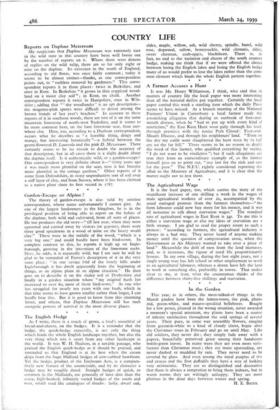The English Hedge
As I write, there is a touch of green, a bird's mouthful of bread-and-cheese, on the hedges. It is a reminder that the hedge, the quick-hedge especially, is net only the thing which binds the whole English landscape together, but also the very thing which sets it apart from any other landscape in the world. It was W. H. Hudson, in a notable passage, who praised the English quick-hedge as it should be praised, and reminded us that England is at its best when the cream drips from the huge Midland hedges of cow-rubbed hawthorn. Yet the hedge, product of the Enclosure Acts, is a compara- tively new feature of the countryside, and by its character a hedge may be roughly dated. Straight hedges of quick, so common in the Midlands, are generally of later date than the crazy, high-banked, infinitely varied hedges of the south and west, which read like catalogues of shrubs : holly, dwarf oak,
elder, maple, willow, ash, wild cherry, spindle, hazel, wild rose, dogwood, sallow, honeysuckle, wild dematis, alder, sweet chestnut, crab-apple, blackthorn. There is, in fact, no end to the variation and charm of the south country hedge, making me think that if we were offered the choice between losing the English lakes and losing the English hedge many of us would prefer to lose the lakes rather than the com- mon element which binds the whole English pattern together.














































 Previous page
Previous page